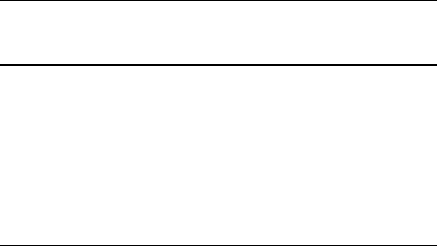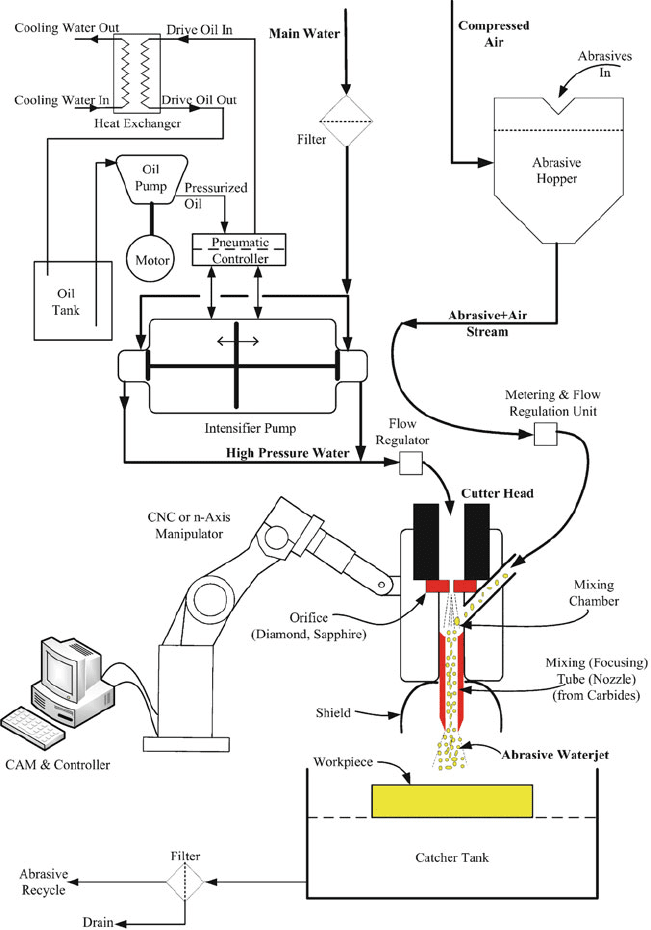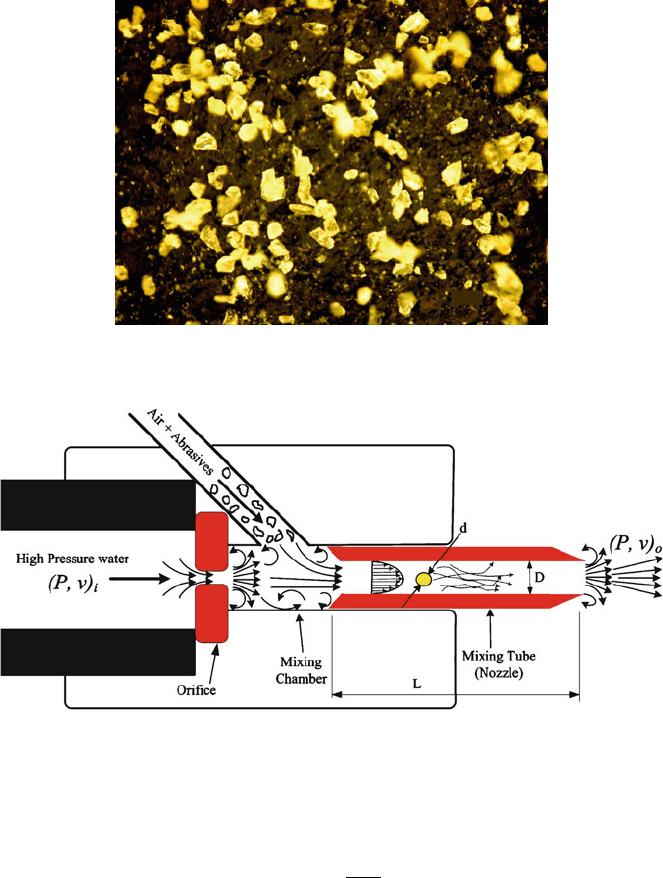Jackson Mark. Machining with Abrasives
Подождите немного. Документ загружается.


Chapter 9
Impact Abrasive Machining
Yasser M. Ali and Jun Wang
Abstract Impact abrasive machining is a broad class of manufacturing processes
that include surface cleaning, descaling, deburring, sand-blasting, shot-peening,
abrasive water or air jet micromachining, and abrasive waterjet (AWJ) cutting,
milling, turning, and drilling. Starting from the basic principles of fluid and solid
mechanics, this chapter describes the underlying physical processes and mechan-
isms affecting jet formation and material removal, and leads to a practical discus-
sion of factors affecting process performance. Adaptations of the basic cutting
process to operations such as milling, turning, micromachining, surface cleaning,
or surface treatment are explained; and various means for process improvement are
discussed. Throughout, focus is on AWJ cutting as the common generic process,
from which all other processes are treated as special cases. This chapter is suitable
for practicing engineers and researchers, and includes an extensive list of references
to guide further study.
Keywords Impact machining Abrasives Micromachining Abrasive water jets
Proce ss modeling
9.1 Introduction
Impact abrasive machining uses a mixture of fluid and solid particles that is
accelerated, then impacts the surface of a target workpiece; thus, causing permanent
deformation or material removal. This definition encompasses a broad field of
processes, with similar physical nature:
J. Wang (*)
School of Mechanical and Manufacturing Engineering,
The University of New South Wales, Sydney, NSW 2052, Australia
e-mail: j.wang@unsw.edu.au
M.J. Jackson and J. P. Davim (eds.), Machining with Abrasives,
DOI 10.1007/978-1-4419-7302-3_9,
#
Springer Science+Business Media, LLC 2011
385
l
When material removal is unfavourable, it is called wear, while favourable mate-
rial removal is called machining. Wear processes (e.g. damage in pipes carrying
abrasive slurry, damage to turbine blades due to particles in the gas stream, surface
erosion by rainfall, etc) were among the early topics studied in tribology; they
provide basic knowledge about material removal mechanisms that may be valid to
machining [1–4].
l
In explosive forming and welding processes [5, 6], a fluid-solid mixture is accel-
erated by radial expansion of gases, presenting conditions of extreme impact
velocity and pressure. However, they do not necessarily form a jet:analmost
unidirectional pencil of narrow flow stream.
l
When a jet removes material from a target surface by impacting at near-normal
angle, the process is called erosion. When impact is at near-tangent angle, it is
called abrasion. Both erosion [7–12] and abrasion [13, 14] may take place during
abrasive jet machining, where the term abrasive refers to the nature of the solid
particles used (being harder than the target material), irrespective of the material
removal mechanisms.
l
Other abrasive machining processes, such as grinding and polishing [15–17],
involve abrasive particles scratching a surface at relatively low velocity (tens of
m/s), whereas processes studied here involve impacting on the surface at hundreds
of m/s – thus, delivering much greater energy.
Acommonformofimpact abrasive machining is the use of a narrow jet of fluid and
solid-particle mixture, which is called Abrasive Jet Machining. The jet can be
composed of any fluid. However, for economic and environmental reasons, it is
usually a mixture of water and air. Other gases, steam, oils, or super-water are used
in special cases. Water has higher density and is incompressible, compared with air;
hence, it is capable of applying greater impact pressure. Water usually contains some
air, and air usually contains some moisture; when referred to as waterjet or airjet,itis
according to the dominant fluid in the jet. Solid particles can be any material, shape, or
size. However, they should be harder than the target workpiece, so that they remove
material from the target at minimum damage to their own. Particles having irregular
shapes with sharp edges can penetrate and cut more into the target, whereas blunt
particles induce more plastic deformation and compressive residual stresses. The
proportion of liquid to solid in the jet can vary significantly. In one extreme, solid
particles are reduced to zero, to have a pure fluid jet. Because of its low mechanical
strength, a pure waterjet can only induce elastic deformation on a solid target.
Prolonged application of a pure jet, or application at near-tangent angle, may result
in fatigue and delamination of a thin surface layer.
There are several manufacturing processes, within the ambit of Abrasive Jet
Machining, that meet the above definitions and limits, as given in Table 9.1. They
share many physical mechanisms and operational attributes, and can be studied as
special cases of one common process:
386 Y.M. Ali and J. Wang

l
Surface cleaning, descaling, deburring, sand blasting, etc are operated using
water, air, or steam jets, with or without abrasives, and are usually applied at
oblique impact.
l
Hydro-honing or shot-peening, uses spher ical cast-iron, hard-steel, or glass
beads as particles, at near-normal impact and relatively low velocity, such that
only plastic deformation – no material removal – is induced.
l
Abrasive airjet micromachining utilizes rough particles, but at low pressure, and
produces only shallow cuts in the target material.
l
Abrasive waterjet milling, turning, drilling, etc, as the more general case.
This chapter focuses on AWJ cutting as the most common process, and other
processes, as identified above, are special cases. We study AWJ in greater detail,
and refer to other processes when applicable. Section 9.2 explains how an abrasive
jet is generated, while Sect. 9.3 studies material removal due to abrasive particles
impact. Sections 9.4 and 9.5 discuss various approaches to improve the process and
various machining operations.
9.2 Generation of Abrasive Jet
Potential energy can be stored in any fluid by compressing it to a high pressure.
However, cost and environmental factors limit the practical options. Oils and other
chemicals are not “green” enough. Steam can be pressurized to 35 MPa, but the
added cost of the boiler is discouraging. In abrasive jet machining, only water and
air seem viable. Air is highly compressible, but moisture condensation is a serious
limitation above 5 MPa. Typical Abrasive Air Jet (AAJ) systems operate ~1 MPa,
and are suitable for micromachining or cleaning applications. Alternatively,
AWJ systems typically operate at pressures up to 400 MPa, and systems up to
600–700 MPa are available [18–21]. They are suitable for deep cutting, even on
hard materials. When pressurized fluid is released through a small opening (orifice),
potential energy is converted into kinetic energy, and a high-speed jet is produced.
Waterjet speeds in excess of 1,000 m/s are available in production.
Table 9.1 Scope of
abrasive jet processes
Water
(super-water,
oils, etc.)
Air (nitrogen,
steam, etc.)
No particles
(oblique impact)
Descaling, paint
stripping,
etc.
Cleaning
Blunt or round particles
(near-normal impact)
Peening Blasting
Irregular sharp particles
(normal or oblique
impact)
Cutting,
machining
Micro-
machining
9 Impact Abrasive Machining 387

Such high pressures are achievable using crankshaft-driven pumps or fluid-driven
intensifiers. Yet, capital, maintenance, and operating costs are excessive at ultra-
high pressures, and there is an economic limit on the maximum usable pressure.
Figure 9.1 shows a schem atic of a typical AWJ machine. Naturally, numerous
commercial variations exist, and there are websites [22, 23] and associations
[24, 25] for waterjet systems manufacturers, where product specifications and
commercial information can be found. This schematic is the general case, treating
pure waterjet and abrasive airjet as special cases of AWJ.
When solid particles are injected into a fluid stream, drag forces result in their
acceleration, and a substantial amount of kine tic energy can be transferred to the
particles. If particle size is relatively large, blunt, and impact velocity is low, it can
only induce on the workpiece residual compressive stresses by plastic deformation,
e.g. in peening processes [26–30]. When particles are small, irregular with sharp
corners, and impact velocity is high, they can penetrate into target material,
removing it, leaving a permanent crater. Typical abrasive particles include garnet,
varieties of sand, corundum (aluminum oxide, Fig. 9.2), silicon carbide, and other
super abrasives such as CBN and synthetic diamond.
The selection of the abrasive material is decided by production econom ics, and
the requirement that particle hardness must be greater than workpiece hardness
(a 1.6 ratio is recommended [31] and 1.25 is absolute minimum [1]) for efficient
material removal. Lower hardness ratios yield excessive particle damage and lower
material removal. Abrasive particle sizes range from tens of micro ns to several
hundred microns, according to a mesh number – or an average characteristic
dimension of the range of particles included. Abrasive particles, their properties,
standards, and suppliers can be found from several associations [32–35].
9.2.1 Pure Fluid Jet
For an ideal potential (incompressible, irrotational, inviscid, and isentropic) fluid
[36], under one-dimensional steady-state flow conditions, energy is conserved, and
P
i
r
i
þ
n
2
i
2
¼
P
o
r
o
þ
n
2
o
2
; (9.1)
where P is hydrostatic pressure, v is average velocity of the stream, and r is fluid
density. The subscripts i and o refer to inlet and outlet of the flow, respectively.
Since, by assumption, r
i
¼ r
o
, P
i
P
o
, and v
o
v
i
,(9.1) reduces to
v
o
ffiffiffiffiffiffiffiffi
2
P
i
r
s
: (9.2)
This is the upper limit on the maximum velocity of a pure fluid jet as it exits the
nozzle (Fig. 9.3.) For a waterjet, r
w
1,000 kg/m
3
, and for 200 P
i
600 MPa,
the maximum jet velocity is 630 v
o
1,100 m/s.
388 Y.M. Ali and J. Wang

Fig. 9.1 Schematic of an abrasive waterjet (AWJ) cutting system
9 Impact Abrasive Machining 389

In reality, water is viscous fluid and flow is rotational. Air is also compressible
and its flow is entropic. For viscous flow in a tube, the Reynolds number, Re,is
Re
tube
¼
rvD
m
: (9.3)
The viscosity of water is m 0.001 Pa.s. For typical well-designed AWJ cutting
heads, the orifice opening in Fig. 9.3 is 0.25–0.5 mm. Inner diameter of the mixing
tube is typi cally ~3 orifice diameter, i.e. 0.75 D 1.5 mm. The mixing tube
length, L, is typically L/D 100. Hence, typical AWJ conditions (10
5
Re
10
6
) are well into the turbulent flow regime. For turbulent flow, fluid motion is
no longer one-dimensional, nor laminar streamlines, and there is a significant
Fig. 9.2 Corundum abrasive particles, nominal size 27 mm
Fig. 9.3 Fluid flow inside an AWJ nozzle
390 Y.M. Ali and J. Wang

amount of energy loses due to vortices and secondary flows. The real exit velocity
of a pure waterjet is less than (9.2). Pressure loses occur at entry and exit across the
orifice, entry and exit across the mixing tube, in the mixing chamber, and due to
friction inside the mixing tube. Th e pressure drop is given by
DP ¼ k
r
v
2
2
; (9.4)
where k is a loss coefficient that is found experimentally and tabulated in fluid
mechanics textbooks [36]. For well-designed and unworn nozzles, k 0.05, for
each loss component. Adding all the losses, the pressure drop from (9.4)is20% of
initial pressure, P
i
. The real exit velocity of a pure jet is v
0r
0.9 v
0
. This quick
calculation formula matche s experimental measurement within 5% [37].
This estimate is for the average velocity of the jet. Yet, point velocity within the
jet varies. It is maximum at the centerline, and almost zero at the turbulent boundary
layer near the wall. The variation of point velocity, u, as a fraction of maximum
center velocity, U, for turbulent flow, follows a 1/7 power law [36]:
uðrÞ
U
¼ 1
2r
D
1
7
; (9.5)
where r is radial distance from center of the tube, 0 r D/2, and U/v
0r
¼ 8/7.
9.2.2 Abrasive Jet
It is common to consider that abrasive particles are entrained by the fluid stream and
gain acceleration, with negligible initial velocity of the particles and perfectly
smooth spheres inside the mixing tube. The accelerating motion of a sphere relative
to a turbulent viscous fluid has no analytical solution, some asymptotic approxima-
tions [38–41] are valid only duri ng the entry stage or very slow (creeping) laminar
flow [36]. An approximate expression for the drag force, F
D
, applied by the fluid on
the particle is
F
D
¼ C
D
pr
8
d
2
w
2
þ
pr
12
d
3
_
w; (9.6)
where C
D
is drag coefficient, d is diameter of the spherical particle, w is relative
velocity between the particle and fluid, and the dot indicates time derivative. The
first term on the right-hand side is due to viscous drag between the sphere and fluid
under steady flow motion, while the second term is the inertia component due to
relative acceleration, which is estimated (albeit for ideal potential flow) from the
concept of virtual mass [42–44]. The drag force is also given by
F
D
¼
p
6
r
s
d
3
_
w; (9.7)
9 Impact Abrasive Machining 391

where r
s
is the density of the sphere. Equating (9.6) and (9.7), simplifying, and
solving the differential equation, with initial condition w(0) ¼ v
0r
, gives
wðsÞ
v
0r
¼ exp
C
D
rs
2dð2r
s
þrÞ
; (9.8)
where s is the distanc e along the length of the mixing tube. The relative velocity
decays exponentially with the distance along the mixing tube. At nozzle exit, s ¼ L.
It can be seen that particle exit velocity is always less than v
0r
, but can be
maximized (i.e. w (L) ! 0) by increasing the drag coefficient or mixing tube length,
or by decreasing the size or density of the sphere (but this also reduces the kinetic
energy stored in the particle). Increasing mixing tube length improves exit particle
velocity; but for economic (e.g. nozzle wear and cost ) and operating (e.g. pressure
losses along the tube) reasons, it cannot be made too long. The drag coefficient can
be approximated as [45]:
C
D
¼ 0.5 400 Re < 3 10
5
C
D
¼ 0.08 Re ¼ 3 10
5
C
D
¼ 0.000366 Re
0.4275
3 10
5
< Re 2 10
6
C
D
¼ 0.18 Re > 2 10
6
where, for a sphere,
Re
sphere
¼
rwd
m
; w ! v
0r
: (9.9)
Hence, there is a critical value, Re ¼ 3 10
5
, beyond which C
D
drops sharply,
and any advantage gained from using higher pump pressure is lost. Increasing water
viscosity, m, reduces turbulent flow and enables more efficient transfer of energy.
It was found experimentally [46] that polymeric additives (e.g. super-water) result
in bigger compact length and better performance of AWJ.
In AWJ, a commonly used abrasive material is garnet, whose density varies
depending on the supplier, but on aver age r
s
4 r
w
. At nozzle exit, s ¼ L 100
D 75 mm for a 0.75 mm nozzle, and from (9.9) and (9.8), it can be found that
w
v
0r
¼
e
1
480d
ðÞ
& v
0r
db0:3: (9.10)
Finally, utilizing (9.2) an approximate expression can be obtained for the
average garnet particle velocity as it exits the nozzle of an AWJ system, i.e.
v
p
0:04
ffiffiffiffiffi
P
i
p
ð1 e
1=480d
Þ & d
ffiffiffiffiffi
P
i
p
b7:4: (9.11)
Real abrasive particles are not spherical. Their irregular shapes result in greater
turbulence and lower drag forces. Some energy is consumed in rigid body rotation
392 Y.M. Ali and J. Wang

of the particles. Further, the above analysis assumes only a single particle. Real
AWJ streams involve numerous particle s, and the energy they absorb reduces
energy available to the flu id. Hence, v
0r
tends to decreases along the length of the
mixing tube. Moreover, drag forces on one particle are lower when it is moving
within the wake of another particle. The rando m motion of particles leads to radial
velocity, frequent inter-particle collisions, and collisions with (and wear of) the
wall of the mixin g tube. Furthermore, inter-particle collisions cause particle frag-
mentation, so that particle size distribution at nozzle exit may be significan tly
different from as-supplied [47]. Finally, (9.11) applies to average particle velocity.
From (9.5), fluid velocity varies along the radial direction, and not all particles are
accelerated equally. However, due to random particles sizes and shapes, turbulent
mixing, and inter-particle collisions, those variations even out and it is a good
estimation to consider that abrasive particles exit the nozzle at almost uniform
velocity distribution.
As the abrasive waterjet is released from the nozzle, constraints applied by the
tube are removed, and the jet is free to expand radially at the expense of further
decrease in axial velocity [37]. In AWJ cutting, there is no advantage in placing the
workpiece at large standoff distance from the nozzle. Standoff is only a clearance,
to avoid collision between the workpiece and nozzle, and to allow an escape path
for rebounding abrasive particles. AWJ machine manufacturers recommend that
standoff distance should be maintained 3D, i.e. 2 mm. At such small standoff,
velocity drop after exit from the nozzle is negligible [48].
All the above uncertainties and inefficiencies reduce the real particle velocity,
v
pr
, as it hits the workpiece surface. It was found from the balance of linear
momentum, and experimentally [49], that
v
pr
¼
av
p
1 þ
_
m
p
=
_
m
w
; (9.12)
where
_
m
p
and
_
m
w
are mass flow rates of the abrasives and waterjet, respectively, and
a is a mixing efficiency coefficient. For well-designed systems, a is typically
0.57 a 0.71. AWJ manufacturers recommend an opti mum abrasive flow
rate
_
m
w
=
_
m
p
50. Notice that (9.12) applies only to the axial component of particle
velocity. Both the radial velocity component and rigid body rotation are ignored,
because of their lesser effect on material removal.
9.2.3 Design Rules
If pressurized water at 400 MPa is released through a 0.25 mm orifice, expands
inside a 0.75 mm mixing tube and hits a target surface spot ~1 mm diameter, even
assuming no loses inside the nozzle, impact pressure at the surface is about one
order of magnitude less. Such low pressure cannot induce plastic deformation or
material removal, except in very soft materials, e.g. plastics, leather, timber, etc.
9 Impact Abrasive Machining 393

[50] A pure waterjet is not suitable for machining metals, ceramics, or other hard
materials. At a large standoff distance, a waterje t may disintegrate into droplets,
whose impact pressure may be high enough to induce residual stresses, e.g. waterjet
peening [30]. Prolonged exposure to waterjet may cause material failure by fatigue,
and consequent delamination of a thin surface layer [10, 11, 51, 52], e.g. waterjet
cleaning, descaling, paint stripping, etc. [53, 54]
In AWJ and AAJ machining of hard materials, the fluid has no direct effect on
material removal, and the impact pressure by the fluid can be ignored. However,
water (and to lesser extent, air) has an important indirect role in machining: it
l
Stores and transfers the energy required to accelerate abrasive particles,
l
Guides the abrasive particles and focuses impacts within a small spot,
l
Flushes debris and abrasive particles away from the workin g zone, and ensures
that fresh surface material is always exposed,
l
Provides some lubrication between the particle and workpiece, reduces frictional
heating, and
l
Provides an effective convection cooling medium, where heat generated during
deformation is immediately extracted from the workpiece. Indeed, this is the
major advantage of AWJ, which is often viewed as a “cold” machining process:
a first choice when cutting heat-sensitive materials.
Notwithstanding all the above contributions of the waterjet, Sect. 9.3 below focuses
only on material removal due to impact by the abrasive particle and ignores the
effect of water on the process.
From the above considerations, it seems appropriate to model the average real
abrasive particle velocity at the time of impact on the workpiece surface as
v
pr
¼ A
_
m
f
ffiffiffiffi
P
i
r
f
q
_
m
p
þ
_
m
f
1
e
BL
d
ðÞ
r
f
2r
p
þr
f
()
&
Cd
m
f
ffiffiffiffiffiffiffiffiffi
P
i
r
f
q
b10
5
; (9.13)
where the subscripts p and f refer to the abrasive particles and jet fluid, respectively,
A, B, and C are parameters that depend on the design of a particular nozzle, vary
with nozzle wear [55], and are best determined experimentally for the specific
configuration, and all other symbols are as defined earlier. In the absence of better
knowledge, for AWJ and for v
pr
within 15%, assume a 0.65, A 0.8,
B 0.25, and C 0.65. For pure airjet or AAJ, due to compressibility of air,
the factor of 2 in (9.2) is reduced to 1.4. A more thorough analysis of AAJ can be
found in [56].
Equation (9.13) captures all the essential features of AWJ generation and the
effect of all major variables:
l
Increasing pressure, P
i
, increases particle velocity, v
pr
, to a limit, beyond which a
sharp decline in drag, B, prevents additional velocity gains.
l
Reducing particle size, d, or density, r
p
, or increasing mixing tube length, L, can
yield limited increase in particle velocity. When the exponential term in (9.13)
almost vanishes, they become ineffective.
394 Y.M. Ali and J. Wang
